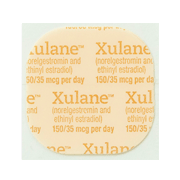Most methods will not cause weight gain. Most people gain weight over time (whether they are using birth control or not), so if you use birth control for a few years, weight gain may not be related to your birth control specifically. The exception to this is the shot. Some people who use the shot will gain some weight. However, the majority of people who use the shot don’t gain much.
Birth control patch

Will birth control make me gain weight?
What's an ovarian cyst?
A cyst is basically a bubble—a collection of fluid with a thin wall around it. Some types of cysts form when a follicle (the fluid-filled sac that develops around an egg during ovulation) grows larger than expected. Sometimes they can cause un-fun symptoms like abdominal discomfort, pelvic pain, pain during bowel movements, or pain during sex. Most cysts disappear on their own, but if they keep growing, they can cause severe pelvic pain or pain that causes dizziness or fainting and comes with a fever or vomiting. If you have any of these severe symptoms, go see a health care provider ASAP. Some hormonal birth control methods—the ones that work by blocking ovulation—may mean fewer ovarian cysts. If you tend to get cysts, your provider might recommend you try a method like the [pill](/birth-control/the_pill}, patch, or [ring](/birth-control/the_ring}.
Does the patch come in more than one color?
Sorry to say, the answer is no. However, you can place the patch on your body where it can’t be seen with clothes on if you don’t like the way it looks.
Want to learn more?
How does the patch work if it just sits on your skin?
The hormones in the patch are similar to those in the pill or ring and work in similar ways to prevent pregnancy, they just get into your body in different ways. The hormones are in the sticky part of the patch, and they get absorbed through the skin and travel through your body to prevent ovulation (a.k.a., releasing an egg from your ovary).
Want to learn more?
How can birth control help an ovarian cyst?
The main ways hormonal birth control prevents pregnancy is by stopping ovulation (when the ovary releases an egg). The pill, patch, ring, and shot are most reliable at blocking ovulation, so people using these methods may have fewer ovarian cysts. If you tend to get ovarian cysts, using these methods helps to prevent future cysts. The progestin-only, a.k.a., mini-pill, has an unpredictable effect on ovulation and may lead to more cysts. These almost always disappear on their own, but if you’ve had problems with cysts in the past, the mini-pill may not be the best option for you.
Can I swim or take a shower while I’m wearing the patch?
Yes, you sure can. It’s rare that the patch falls off, but it does happen.
Want to learn more?
It seems like every birth control has side effects. Is it really worth it?
There are positive and negative things to say about every method. And everyone’s different—so what you experience may not be the same as what someone else experiences. And what side effects are “worth it” to you might be different than for someone else.
You can start by thinking about what’s most important to you about your method. Is your top priority using the method that will be the most effective at preventing pregnancy? Something easy to use? Something that makes your period lighter? Something that you can stop and start without seeing a provider? There are birth control options for all of these. It’s also common to try more than one birth control option before finding one that works for you, so don’t settle if your current option isn’t working.
Are there benefits to birth control other than just controlling fertility?
There are a lot of great things about being on birth control that go beyond pregnancy prevention. Protection against ovarian cancer, an added boost to your vitamin D levels, lighter and less painful periods, the list goes on.
Want to learn more?
Which birth control method will help reduce my cramps?
Most people who use hormonal birth control—combination pill, patch, ring, implant, shot, and hormonal IUDs—will have less painful periods than those who don’t. This is because these methods of birth control make the lining of the uterus thinner. There’s less tissue in the uterus to shed (that’s what happens when you have your period), so periods are lighter. One special note on the implant and the shot: for some people, these methods cause more days of spotting or bleeding in between periods, but periods become lighter and less painful overall.
Does birth control cause blood clots?
Progestin-only methods like the implant, mini-pill, shot, and IUDs don’t increase your risk. If you’re worried about blood clots, we recommend talking to a health care provider about which birth control options are the safest for you.
Using a method of birth control with estrogen, like the combination pill, patch, and ring, increases your risk of forming a blood clot, but if you have no history of stroke, blood clots, or heart attack, and your family members have never experienced a blood clot, the risk is still quite low. If you have a history of these medical conditions, you have a higher risk of forming a new blood clot already so adding birth control with estrogen to the mix increases that risk and isn’t recommended.
Progestin-only methods like the implant, mini-pill, shot, and IUDs don’t increase your risk. If you’re worried about blood clots, we recommend talking to a health care provider about which birth control options are the safest for you.
Want to learn more?
What should I do about skin irritation from the patch?
Some people do experience irritation from the adhesive in the patch.
Try this: You could try moving it to another recommended spot on your body to see if that lessens the effect. You can also put a little over-the-counter cortisone cream on the affected area to help reduce the irritation. Or, if you’ve been moving it around, try keeping it in one spot.
Want to learn more?
What should I do before stopping my birth control?
If you’d like to stop your birth control and try to get pregnant, you can get pregnant pretty quickly after stopping most methods.
If you’re just not vibing with your choice of birth control, it might be time to switch things up! Before you do, ask yourself some questions to make sure you know what’s not working and what you might want in a new method. Thinking about why you want to switch methods and what your needs are going forward will help you figure out next steps that work for you.
If you’d like to stop your birth control and try to get pregnant, you can get pregnant pretty quickly after stopping most methods.

Heat up your weekends with our best sex tips and so much more.